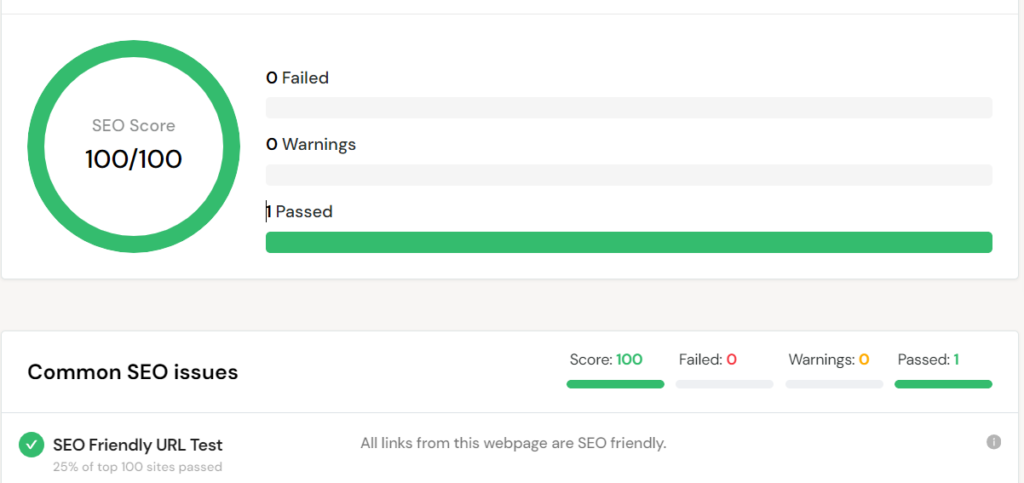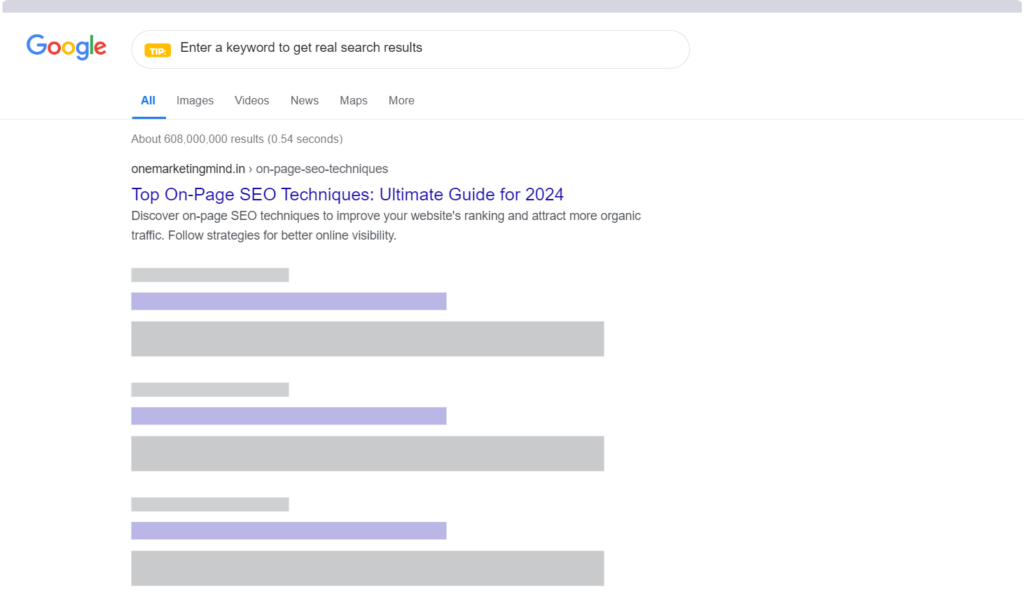Are you struggling to boost your website’s visibility on search engine results pages? Wondering how to make your web pages more appealing to search engines? Dive into our comprehensive guide on On-Page SEO Techniques. Learn the secrets to optimizing your website for better search engine rankings.
In this post, we’ll explore a range of effective strategies, from keyword research to content optimization. These will help you improve your on-page SEO efforts. By the end of this blog post, you’ll gain valuable insights and actionable tips to improve your website’s performance. And this will help you to attract more organic traffic.
On-Page SEO is one the part of SEO Techniques. On-page SEO techniques play a crucial role in improving your website’s visibility and ranking on SERPs. Optimizing various elements within your individual pages can impact your site’s performance and attract more organic traffic.
So be ready to learn the important and helpful On-Page SEO techniques in this guide.
Table of Content
What is On-Page SEO?
Before diving into specific techniques, it’s essential to grasp the concept of on-page SEO. This involves optimizing individual web pages to rank higher and earn more relevant traffic in search engines. On-page SEO focuses on optimizing content and HTML source code elements.
12 On-Page SEO Techniques
1. Keyword Research and Optimization

Keyword research is the foundation of on-page SEO. Identify relevant keywords and phrases that your target audience is likely to search for. Integrate these keywords strategically into your content, including titles, headings, and body text, while ensuring natural readability.
Example: A bakery website might target keywords like “best chocolate cake recipe” or “artisan bread delivery.”
Best Practice: Use tools like Google Keyword Planner or SEMrush to research keywords, focus on long-tail keywords, and integrate them naturally into your content.
Recommended tools to use : Google keyword planner, Moz, SEMRush, Ahref, Ubersuggests,
2. Title Tags and Meta Descriptions
Title tags and meta descriptions are HTML elements that provide concise summaries of web page content. Optimize title tags with primary keywords and ensure they are compelling to attract clicks. Meta descriptions should accurately describe the page’s content and include relevant keywords.
Example: Title Tag: “Delicious Chocolate Cake Recipe | Grandma’s Bakery”; Meta Description: “Indulge in our decadent chocolate cake made with the finest ingredients. Order online for delivery.”
Best Practice: Keep title tags under 60 characters, meta descriptions under 160 characters, include primary keywords, and make them compelling to encourage clicks.
3. URL Structure Optimization

Optimize your URLs to be descriptive, concise, and include targeted keywords. Avoid using long, complex URLs and include relevant keywords near the beginning for better search engine visibility.
Example: www.bakery.com/chocolate-cake-recipe
Best Practice: Keep URLs concise, descriptive, and include targeted keywords. Avoid using unnecessary characters or parameters.
Recommended tools: seo friendly url test , Url slug generator
4. Heading Tags (H1, H2, etc.)
Use heading tags (H1, H2, etc.) to structure your content logically and make it more readable for both users and search engines. Include primary keywords in your H1 tag and use H2-H6 tags for subheadings to organize your content effectively.
Example: H1: “Welcome to Grandma’s Bakery”; H2: “Our Specialty: Chocolate Delights”
Best Practice: Use H1 for main headings, incorporate primary keywords, and use H2-H6 for subheadings to organize content logically.
5. Content Optimization
Create high-quality, relevant, and engaging content that provides value to your audience. Incorporate targeted keywords naturally throughout your content, focusing on user intent and readability. Aim for comprehensive, well-researched content that satisfies user queries.
Example: Create a blog post titled “10 Tips for Baking the Perfect Chocolate Cake” with detailed instructions and tips.
Best Practice: Produce high-quality, comprehensive content that satisfies user intent, incorporates keywords naturally, and provides value to the audience.
6. Image Optimization
Optimize images on your website by using descriptive filenames and alt text that include relevant keywords. Compress images to improve page load times without sacrificing quality, enhancing both user experience and SEO performance.
Example: Image Filename: chocolate-cake.jpg; Alt Text: “Delicious Chocolate Cake with Icing”
Best Practice: Use descriptive filenames and alt text, compress images for faster loading times, and ensure they enhance user experience.
Alt tags: Optimizing alt tags can boost your Image SEO, here are some important points to remember for optimising alt tags
- It should be Descriptive and Concise: Ensure alt tags accurately describe the image content in a concise manner, providing a clear understanding of the image’s purpose.
- Keyword Integration: Include relevant keywords naturally within alt tags to enhance SEO without overstuffing, maintaining readability and relevance.
- Accessibility Improvement: Use alt tags to improve website accessibility for visually impaired users who rely on screen readers to interpret images.
- Contextual Relevance: Make sure alt tags provide context that complements the surrounding content, helping search engines and users grasp the image’s role in the article.
- Avoid Redundancy: Avoid using phrases like “image of” or “picture of” in alt tags, as this is redundant. Focus on what is essential and specific about the image.
7. Internal and External Linking Strategies
Internal Linking
Utilize internal linking to establish a hierarchical structure within your website and distribute link equity across pages. Link relevant pages together using descriptive anchor text to help users navigate your site and improve search engine crawlability.
Example: Link from a blog post about chocolate cake to the bakery’s main cake collection page.
Best Practice: Use descriptive anchor text, link to relevant pages within your site, and establish a logical hierarchy for navigation.
External Linking
Utilize external linking to build credibility and provide additional value to your readers by connecting them to reputable sources. External links can help search engines understand the relevance and quality of your content. Use descriptive anchor text when linking to external sources to ensure clarity and improve user experience.
Example: Link from a blog post about digital marketing strategies to an authoritative source like a well-known marketing research website.
Best Practice: Use descriptive anchor text, link to reputable and relevant external sources, and ensure that external links open in a new tab to keep users on your site longer.
Key Points to remember
- External links to reputable sources can enhance your content’s credibility and trustworthiness.
- Guide your readers to high-quality external content that complements your own, adding value to their experience.
- Search engines recognize external links as indicators of content quality, helping to improve your page’s SEO.
- Ensure the anchor text for external links clearly describes the linked content, improving user understanding and SEO.
- Configure external links to open in new tabs, keeping users engaged with your content while accessing external information.
8. User Experience and Page Speed
Prioritize user experience by optimizing page speed, mobile responsiveness, and overall site performance. Improve load times by optimizing images, leveraging browser caching, and minimizing server response times to enhance user satisfaction and SEO rankings.
Example: Optimize images, enable browser caching, and minimize server response times to improve page load speed.
Best Practice: Prioritize mobile responsiveness, optimize for fast loading times, and provide a seamless browsing experience across devices.
9. Mobile Optimization
With the increasing prevalence of mobile devices, optimizing your website for mobile is essential for SEO success. Ensure your site is mobile-friendly, with responsive design, fast load times, and intuitive navigation to provide a seamless experience for mobile users.
Example: Ensure that the website’s design adjusts seamlessly to different screen sizes and devices.
Best Practice: Use responsive design, optimize for touch interactions, and prioritize fast loading times on mobile devices.
10. Schema Markup Implementation
Implement schema markup to provide search engines with additional context about your content and enhance its visibility in SERPs. Use structured data markup to highlight important information such as reviews, events, recipes, and more, improving click-through rates and attracting more qualified traffic.
Example: Markup a recipe with schema.org/Recipe to provide additional context to search engines.
Best Practice: Implement structured data markup for important information such as reviews, events, or products to enhance visibility in SERPs.
11. Regular Content Updates and Maintenance
Stay proactive with your on-page SEO efforts by regularly updating and maintaining your website’s content. Monitor performance metrics, identify areas for improvement, and adapt your strategies to evolving search engine algorithms and user preferences.
Example: Update blog posts with new information, refresh outdated content, and fix broken links.
Best Practice: Monitor performance metrics, stay informed about industry trends, and adapt your content strategy to evolving search engine algorithms and user preferences.
12. Featured Snippets
Featured snippets are brief answers displayed at the top of Google’s search results, often providing users with direct, concise information. Optimizing for featured snippets can significantly boost your visibility and drive more traffic to your site.
Examples of Featured Snippets
- Paragraph Snippet: For a search query like “What is on-page SEO?” a paragraph snippet might provide a concise definition of on-page SEO.
- List Snippet: For a query such as “Steps to optimize on-page SEO,” a list snippet could outline the steps in a bulleted or numbered list.
- Table Snippet: For queries like “Comparison of on-page and off-page SEO,” a table snippet might display a side-by-side comparison.
Best Practices for Optimizing for Featured Snippets
- Identify Snippet Opportunities: Use tools like Ahrefs or SEMrush to find queries that already have featured snippets. Analyze the content that appears and identify gaps or opportunities for improvement.
- Structured Content: Structure your content to directly answer potential snippet queries. Use clear headings (H2, H3), bullet points, and numbered lists to organize your information.
- Concise and Clear Answers: Provide direct and concise answers within the first 100 words of your content. Make sure the answer is relevant and accurate.
- Use Question-Based Headings: Frame your headings as questions similar to how users might search, like “How to optimize on-page SEO?” and provide clear, succinct answers immediately following the heading.
- Leverage Schema Markup: Implement schema markup to help search engines understand your content better and increase your chances of being selected for a featured snippet.
Conclusion
In conclusion, mastering on-page SEO techniques is crucial for improving your website’s visibility and attracting organic traffic. By implementing strategies such as keyword research and optimization, optimizing meta tags, creating high-quality content, and enhancing user experience, you can effectively optimize your web pages for search engines. Remember to regularly monitor and analyze your website’s performance to identify areas for improvement and stay ahead of the competition.
Now that you have a comprehensive understanding of on-page SEO techniques, it’s time to put your knowledge into action. Whether you’re a beginner looking to optimize your website for the first time or a seasoned SEO professional seeking to refine your strategy, our blog provides valuable insights and resources to help you succeed. Keep exploring our blog for more tips, tricks, and guides on all things related to digital marketing and SEO.
You may also like to read a guide to On Page SEO Vs Off page SEO key differences.
Frequently Asked Questions about On-Page SEO Techniques
Why is On-Page SEO Important?
On-page SEO is crucial because it directly impacts your website’s visibility and ranking on search engine results pages (SERPs). By implementing effective on-page SEO techniques, you can improve your chances of ranking higher in search results and attracting relevant traffic to your site.
What are Some Key On-Page SEO Techniques?
Some key on-page SEO techniques include keyword research and optimization, optimizing title tags and meta descriptions, improving URL structure, using heading tags effectively, creating high-quality content, optimizing images, implementing internal linking strategies, prioritizing user experience and page speed, and optimizing for mobile devices.
How Can I Optimize Content for On-Page SEO?
To optimize content for on-page SEO, focus on creating high-quality, relevant, and engaging content that provides value to your audience. Incorporate targeted keywords naturally throughout your content, and ensure it aligns with user intent. Aim for comprehensive, well-researched content that satisfies user queries.
What are the Benefits of Implementing On-Page SEO Techniques?
Implementing on-page SEO techniques can lead to various benefits, including higher search engine rankings, increased organic traffic to your website, improved user experience, higher conversion rates, and better overall online visibility and presence.


